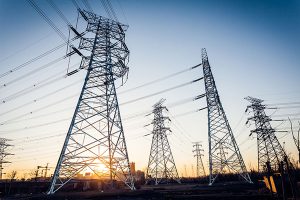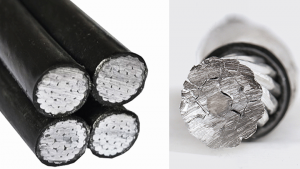In the world of power distribution, technological advancements have paved the way for more efficient and reliable solutions. Overhead Bundled Cables, also known as Aerial Bundled Cables (ABC), have emerged as a game-changer in the industry. These cables offer a safer and more effective alternative to traditional bare conductor cables used in overhead power transmission. In this article, we will explore the features, advantages, and applications of Overhead Bundled Cables, shedding light on their importance in modern power distribution systems.
What are Overhead Bundled Cables?
Overhead Bundled Cables, or ABC cables, are a type of electrical cable used for power distribution at voltage levels of up to 1000V. Unlike conventional bare conductor cables, ABC cables consist of multiple insulated conductors tightly bundled together, providing enhanced safety and reliability. The insulation layers surrounding each conductor prevent short circuits caused by external forces such as wind or falling branches, reducing the risk of power outages and electrical accidents.

Advantages of Overhead Bundled Cables
Overhead Bundled Cables offer several advantages over traditional bare conductor cables. Let’s explore some of the key benefits that make ABC cables a preferred choice for power distribution:
Improved Safety
The insulated conductors in ABC cables significantly reduce the risk of electrocution and power faults caused by accidental contact. The insulation acts as a barrier, preventing direct contact with live conductors and enhancing overall safety for both workers and the public.
Reduced Power Losses
Overhead Bundled Cables exhibit excellent electrical performance, resulting in lower power losses during transmission. This improved efficiency translates into cost savings and a more sustainable power distribution system.
Enhanced Reliability
ABC cables are designed to withstand various environmental conditions, including extreme temperatures and UV radiation. The insulation materials used in these cables provide excellent resistance to aging, ensuring long-term reliability and uninterrupted power supply.
Easy Installation and Maintenance
The installation of ABC cables is simpler and more cost-effective compared to traditional bare conductor systems. The bundled design eliminates the need for crossbars and insulators, reducing installation time and labor requirements. Additionally, the robust construction of ABC cables minimizes the need for frequent maintenance, further reducing operational costs.
Versatile Application
Overhead Bundled Cables are suitable for various applications, including residential, commercial, and industrial power distribution. Their flexibility and adaptability make them an ideal choice for urban and rural areas, where space constraints and challenging terrain can pose significant obstacles to traditional power transmission systems.
Construction of Overhead Bundled Cables
The construction of Overhead Bundled Cables involves several key components that work together to ensure efficient power distribution. Let’s take a closer look at the main elements of ABC cables:
Phase Conductors
The phase conductors carry the electrical current and are typically made of aluminum. These conductors are stranded and have a circular and smooth surface, ensuring optimal conductivity and minimizing power losses.
Neutral Conductor
The neutral conductor, also known as the messenger conductor, provides a return path for the current. It is typically a bare, round, stranded aluminum alloy wire. The neutral conductor helps maintain the balance of the electrical system and supports the bundled arrangement of the phase conductors.
Insulation
The insulation material surrounds each phase conductor, providing electrical insulation and protection against external factors. Common insulation materials used in ABC cables include PVC (Polyvinyl Chloride), PE (Polyethylene), and XLPE (Cross-linked Polyethylene). The insulation materials are selected based on their ability to withstand voltage, temperature, and environmental conditions.
Supplementary Note
The size of Overhead Bundled Cables is measured in square millimeters (mm²). The standard sizes of ABC cables vary depending on regional regulations and specific application requirements.

Types of Overhead Bundled Cables
Overhead Bundled Cables come in different types to cater to various voltage levels and specific application needs. Let’s explore the main types of ABC cables:
Low Voltage Aerial Bundled Cables
These cables are designed for overhead power lines and room entrance wires with a rated AC voltage of 1kV and below. Low-voltage ABC cables offer cost-effective power transmission solutions with low installation, maintenance, and operating costs. They are available in different conductor materials, including copper, aluminum, and aluminum alloy, and comply with international standards such as IEC, BS, and ASTM.
Medium Voltage Aerial Bundled Cables
Medium voltage ABC cables are suitable for power grid transformation in urban, forest, and coastal areas. They can handle voltage levels of 10kV and below, offering reliable and efficient power transmission. The conductor material used is usually aluminum, and the insulation material is typically XLPE. Medium voltage ABC cables meet international standards such as IEC, NF C33-209, and GB.
Duplex/Triplex Service Drop Wire
Duplex or triplex service drop wires are used for overhead service applications, such as street lighting and building temporary services. These wires have high tensile strength and can carry loads of up to 120V. The conductor material is typically aluminum, and insulation materials include PVC and XLPE. Duplex/triplex service drop wires comply with standards such as ASTM and ICEA.
Advancements and Applications of Overhead Bundled Cables
Overhead Bundled Cables have revolutionized power distribution systems worldwide, offering numerous advantages and applications. Let’s explore some of the key advancements and application fields of ABC cables:
Urban Power Distribution
Overhead Bundled Cables are particularly suitable for urban power distribution systems due to their compact design and ease of installation. They allow for efficient power transmission in congested areas, where space limitations and aesthetic considerations are important factors.
Rural Electrification
ABC cables have played a crucial role in rural electrification projects, bringing reliable and cost-effective power to remote areas. The ease of installation and reduced maintenance requirements make ABC cables an excellent choice for extending power distribution networks to underserved communities.
Coastal and Forest Areas
Overhead Bundled Cables are highly resilient to environmental challenges, making them ideal for power distribution in coastal and forest areas. The insulation materials used in ABC cables offer excellent protection against UV radiation, moisture, and extreme temperatures, ensuring reliable performance even in harsh conditions.
Reliability Improvement
Overhead Bundled Cables have significantly improved the reliability of power distribution systems. The insulation layers surrounding each conductor prevent faults and short circuits caused by external factors, reducing power outages and minimizing downtime. This enhanced reliability is crucial for critical infrastructure, such as hospitals, data centers, and industrial facilities.
Safety Enhancement
The use of ABC cables has greatly enhanced safety in power distribution systems. The insulation provided by ABC cables reduces the risk of accidental contact with live conductors, minimizing the chances of electrocution and electrical accidents. This makes ABC cables a preferred choice in public areas, residential neighborhoods, and other high-traffic locations.
Conclusion
Overhead Bundled Cables have improved safety, reliability, and efficient power distribution capabilities and have become an integral part of modern power grids. These cables offer numerous advantages over traditional bare conductor systems, making them a preferred choice for power transmission in various settings. With advancements in technology and ongoing research, the future of Overhead Bundled Cables looks promising, promising even more efficient and sustainable power distribution systems for the world.